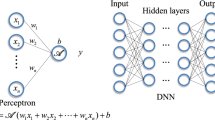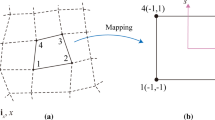Abstract
The advancement of computers has led to collection and handling of huge data from various resources. The inherent properties of computational mechanics application can be extracted from the appropriate data using different techniques of machine learning (ML). The present work enlights a method to employ machine learning in the field of finite element method (FEM) where evaluation of sufficient number of integrals has to be carried out. This calculation of integral by the standard Gauss–Legendre quadrature rule requires specific number of Gauss quadrature points for getting the desired accuracy which minimizes the computational cost. Whereas the element stiffness matrix is calculated numerically with required number of Gauss quadrature points for different element with respect to the material properties. Most of the auto-mesh software consider constant number of Gauss quadrature points for all the elements irrespective of their distortion and material behaviour. The main motivation of this work is to build an accurate and computationally efficient quadrature scheme with the help of standard Gauss–Legendre quadrature rule for computing elemental stiffness matrix. An efficient method is developed using a deep neural network to predict respective number of Gauss quadrature points for given element coordinates and the material properties.
Access this chapter
Tax calculation will be finalised at checkout
Purchases are for personal use only
Similar content being viewed by others
References
Alizadehsani R, Roshanzamir M, Abdar M, Beykikhoshk A, Khosravi A, Panahiazar M, Sarrafzadegan N (2019) A database for using machine learning and data mining techniques for coronary artery disease diagnosis. Scientific Data 6(1):1–13
Chen PHC, Liu Y, Peng L (2019) How to develop machine learning models for healthcare. Nat Mater 18(5):410–414
Capuano G, Rimoli JJ (2019) Smart finite elements: a novel machine learning application. Comput Methods Appl Mech Eng 345:363–381
Dogan Ü, Edelbrunner J, Iossifidis I (2011) Autonomous driving: a comparison of machine learning techniques by means of the prediction of lane change behavior. In: 2011 IEEE international conference on robotics and biomimetics. IEEE, pp 1837–1843
Khan AI, Al-Habsi S (2020) Machine learning in computer vision. Proc Comput Sci 167:1444–1451
Rovinelli A, Sangid MD, Proudhon H, Ludwig W (2018) Using machine learning and a data-driven approach to identify the small fatigue crack driving force in polycrystalline materials. NPJ Comput Mater 4(1):1–10
Ozarde AP, Narayan J, Yadav D, McNay GH, Gautam SS (2021) Optimization of diesel engine’s liner geometry to reduce head gasket’s fretting damage. SAE Int J Eng 14(1)
Gautam SS, Khan KM (2020) Detection of fretting fatigue using machine learning algorithms, 3rd structural integrity conference and exhibition (SICE 2020)—“structural integrity at multiple length scales” (e-Conference), IIT Bombay
Vithalbhai SK, Gautam SS (2021) A machine learning approach to fretting fatigue problem. In: International conference on futuristic technologies (e-Conference)—structural health monitoring, energy harvesting, green material and biomechanics, IIT Delhi
Liang L, Liu M, Martin C, Sun W (2018) A deep learning approach to estimate stress distribution: a fast and accurate surrogate of finite-element analysis. J R Soc Interface 15(138):20170844
Ozkan MT, Erdemir F (2021) Determination of theoretical stress concentration factor for circular/elliptical holes with reinforcement using analytical, finite element method and artificial neural network techniques. Neural Comput Appl 33(19):12641–12659
Gouravaraju S, Narayan J, Sauer RA, Gautam SS (2023) A Bayesian regularization-backpropagation neural network model for peeling computations. J Adhesion 99(1):92–115
Oishi A, Yagawa G (2017) Computational mechanics enhanced by deep learning. Comput Methods Appl Mech Eng 327:327–351
Yu B (2018) The deep Ritz method: a deep learning-based numerical algorithm for solving variational problems. Commun Math Stat 6(1):1–12
Cheng R, **aomeng Y, Chen L (2022) Machine learning enhanced boundary element method: prediction of Gaussian quadrature points. CMES-Comput Model Eng Sci 131(1):445–464
Funahashi KI (1989) On the approximate realization of continuous map**s by neural networks. Neural Netw 2(3):183–192
Srivastava N, Hinton G, Krizhevsky A, Sutskever I, Salakhutdinov R (2014) Dropout: a simple way to prevent neural networks from overfitting. J Mach Learn Res 15(1):1929–1958
Ioffe S, Szegedy C (2015) Batch normalization: accelerating deep network training by reducing internal covariate shift. In: International conference on machine learning. PMLR, pp 448–456
Vithalbhai SK, Nath D, Agrawal V, Gautam SS (2022) Artificial neural network assisted numerical quadrature in finite element analysis in mechanics. Materials Today: Proceedings 66:1645–1650
Acknowledgements
The authors gratefully acknowledge the support from SERB, DST under project IMP/2019/000276 and VSSC, ISRO through MoU No.: ISRO:2020:MOU:NO: 480.
Author information
Authors and Affiliations
Corresponding author
Editor information
Editors and Affiliations
Rights and permissions
Copyright information
© 2023 The Author(s), under exclusive license to Springer Nature Singapore Pte Ltd.
About this paper
Cite this paper
Chinchkar, R., Nath, D., Gautam, S.S. (2023). Design of Efficient Quadrature Scheme in Finite Element Using Deep Learning. In: Sharma, R., Kannojiya, R., Garg, N., Gautam, S.S. (eds) Advances in Engineering Design. FLAME 2022. Lecture Notes in Mechanical Engineering. Springer, Singapore. https://doi.org/10.1007/978-981-99-3033-3_3
Download citation
DOI: https://doi.org/10.1007/978-981-99-3033-3_3
Published:
Publisher Name: Springer, Singapore
Print ISBN: 978-981-99-3032-6
Online ISBN: 978-981-99-3033-3
eBook Packages: EngineeringEngineering (R0)




